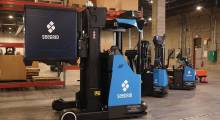You didn’t have to walk far at Modex 2018 to see some type of material handling robot edging by. There were many small, cart-sized autonomous mobile robots (AMR) moving around tugging carts or rolling shelves, collaborative robotic arms that do piece picking, robots with tilt tray sorter attachments or roller conveyor sections on top of them, and bigger robots to move heavy loads.
For all the eye-catching arms, grippers, and navigation sensors hanging off these robots, it can be easy to forget how software-driven they are. Robotics vendors may stress features like grippers, or specific material handling tasks their bots can do, but most will also point out it takes software to control a robot’s tasks based on sensor inputs and allow it to learn from the work it’s performing.
But there was another important software trend playing out at Modex beyond the software intelligence needed for robotics. There were several announcements aimed at the software level that sits between traditional warehouse management system (WMS) software and the more real-time warehouse control system (WCS) layer which governs automated materials handling equipment.
This “space” has become known as the warehouse execution system (WES) layer. While WES is not new, and a wide range of functions fall under the WES umbrella, there continued to be product announcement from WES vendors, with more focus on advanced monitoring and analytics functions.
There was one new company—redPILOT, part of KNAPP Group—that introduced an analytics-enabled control tower that, while not positioned as a WES, offers software for optimizing activity and resource assignments in automated warehouses. You can read about their Modex press conference here.
Another source of WES news at a Modex came not from WES vendors, but from two well-known WMS vendors. HighJump Software announced their “Automation Aware” WMS, while Manhattan Associates talked about a soft launch of some embedded WES functionality for its Open Systems WMS.
At a booth visit, Sean Elliott, CTO for HighJump, said the automation-aware WMS functions can make use of WCS from Inconso, a European company that is now a sister company to HighJump under parent company Körber. The automation-aware functions can plug into other WCSs as well, Elliott said, though the WMS users would see the automation insights from within WMS. “We have everything flow through one user experience,” he said.
The goal of the new capability, said Elliott, is to transform WMS from a system that manages a warehouse from the perspective of inventory and people activity, to one that can also manage activity in tight concert with automated systems.
The march of ecommerce, labor shortage issues, and the addition of more automation makes an “automation aware” WMS approach a natural direction, said Elliott.
“You can’t live now without automation in many warehouses. “You can’t just rely only on systems for managing people.”
Automation-aware WMS will keep close tabs on machine and labor capacity issues, Elliott said, and provide visibility into automated machinery, such as whether goods are accumulating on a conveyor or a divert on a sorter is having problems.
At a Manhattan Associates booth visit, Eric Lamphier, senior director of product management for Manhattan, said the WES functionality being added to the WMS will build on the “order streaming” functionality Manhattan has offered for about two years. Order streaming breaks WMS order releasing into small chunks of work that can be more easily processed in a continuous manner.
The WES functionality in Manhattan’s WMS will allow users to “orchestrate across human labor and machines,” said Lamphier. “We feel that’s a pretty important capability today, especially for omnichannel environments.”
Manhattan plans to formally launch the WES functions at its user conference in May. It will be categorized as a module, but will be embedded functionality that will not require additional license fees.
Vendors with established WES solutions, of course, weren’t standing still at Modex. Honeywell Intelligrated highlighted new capabilities in its Momentum package, and Swisslog showcased some of the newer functions for its SynQ WES solution, including condition monitoring software that collects, analyzes, and provides a workflow for appropriate action. The overall direction with SynQ is to leverage analytics and workflows to drive improvements from the data generated by warehouse automation, explained Steve Thorne, director of Solutions Architecture for Swisslog Warehouse and Distribution Solutions (WDS) Americas.
So while the robots drew the eyes at Modex, it’s really the evolution of the software layer that sits between automation and higher-level warehouse management that bears some closer watching. The traditional lines between automation, WCS, and WMS continued to blur at Modex 2018, and there are new vendor offerings coming into the market with advanced analytics that are quite different from the monitoring and reporting typically found within WCS deployments. The need to better manage both labor and machines in digital-age fulfillment centers, along with the intensive piece picking and order cycle pressures that entails, is driving the evolution of this crucial software layer.
Article topics








